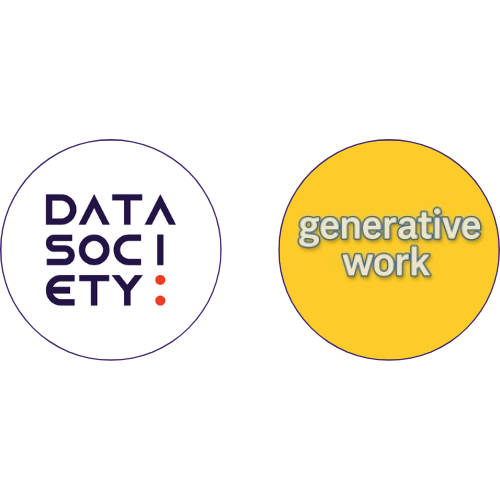There’s a reason every industry conversation right now seems to circle back to AI. The technology is moving at breakneck speed, promising massive gains in productivity, innovation, and insight. But for most organizations, the biggest challenge isn’t whether to invest in AI–it’s how to actually make it stick.
What’s the best way to upskill thousands of employees when the tech changes monthly? How do you drive adoption of AI tools people barely understand? And how do you ensure learning isn’t just another checkbox–but something that transforms how people work?
To answer those questions, we sat down with Robert Daniel, Chief Revenue Officer of Data Society Group, who’s been at the forefront of helping Fortune 500 companies and federal agencies navigate this exact moment.
“Right now there is just a big need on all things AI–whether that’s advanced courses through our partnership with NVIDIA’s Deep Learning Institute or foundational AI literacy and prompt engineering,” Daniel shared. “That’s a huge theme we see continuing for the foreseeable future.”
In other words, the hunger to learn is real. The question is no longer if companies need to upskill their workforce–but how to do it effectively.
LEARN MORE: AI in Learning & Development: Hype vs. Real Impact
AI Upskilling Alone Isn’t Enough—It Has to Be Part of the Culture
One of the most common mistakes Daniel sees? Treating training as a stand-alone event.
“The right clients are putting training as part of larger programs… If there’s a big organizational push around AI and changing your culture to embrace it, then training works as part of that,” he explained. “But when it’s isolated–just another course assigned to someone’s inbox–it doesn’t land.”
Learning becomes one spoke in the wheel–not the wheel itself.
At Data Society, that’s why programs are often designed alongside advisory engagements or strategic planning. It’s not just about the training–it’s about helping teams see what’s possible and building a roadmap.
Redefining Success: From Attendance to Adoption

Once training is in place, how do you measure its effectiveness?
“We’ve done some great programs where companies are measuring success based on how often employees are using the tools available to them, and how effectively they’re using them to improve their workflows,” Daniel said.
Rather than focusing on completion rates or post-course surveys, the most forward-thinking organizations are asking: Are people actually using AI in their daily work?
That approach represents a major shift. It turns learning from a passive event into an active business driver—one that can be tracked, optimized, and aligned with key performance indicators.
With AI upskilling in particular, the goal isn’t just awareness, it’s integration. Success means employees are applying what they’ve learned to real use cases, automating tasks, enhancing decision-making, and collaborating more effectively with AI tools. It’s not about checking boxes. It’s about changing behavior.
MUST READ: Why Data Literacy is the Secret Weapon of High-Performing Teams
Live Learning Still Matters–Especially at Scale
In an era where most corporate learning has moved online, it might be surprising to hear Daniel advocate for live learning. But when it comes to changing behavior at scale, live sessions still have a powerful role to play.
“The case study we published with Hearst was great. They did over a hundred live sessions with employees in a three-month period,” Daniel recalled. “That drove a massive increase in usage and adoption.”
That level of intentional engagement–especially in a hybrid or remote setting–makes all the difference.
Hearst’s success wasn’t an accident. It resulted from strategy, time investment, and a willingness to meet people where they are–whether that meant webinars, office hours, or interactive workshops.
AI Is Reshaping the Learning Experience Itself
Of course, AI isn’t just the subject of today’s training–it’s also shaping the future of how people learn.
“We’re already seeing companies leverage AI for personalization,” Daniel said. “There are tools now that act as assistants, helping guide learning outcomes. I expect to see a lot more of that, especially from the big asynchronous platforms.”
That kind of personalization means organizations can move away from one-size-fits-all learning and toward highly customized experiences–at scale.
What Should Learning Leaders Do Right Now with AI Training Courses?
The pace of change can feel overwhelming, especially for leaders tasked with making long-term decisions in short timeframes. Daniel’s advice?
“Pick a starting point, something you can accomplish in the next 90 days, and map it to your larger goals,” he said. “Start with the end in mind and work your way backward.”
That kind of strategic clarity helps organizations avoid the trap of reactive decision-making and instead focus on meaningful, sustained progress.
And yes, this applies to every industry.
“Every org arguably has almost too many tools right now,” Daniel added. “The key is figuring out how to leverage what you already have, build in continuous learning, and keep the dialogue going with employees as the tech evolves.”
AI training courses play a critical role in this process. The right programs don’t just teach what the tools can do, they show how to use them in context, with practical exercises and real-world applications. From foundational awareness to advanced capabilities, these courses provide a roadmap for continuous learning that adapts alongside the technology.
Whether it’s Microsoft Copilot, OpenAI tools, or industry-specific AI applications, the landscape is changing fast. The organizations that thrive will be the ones that treat learning as a journey, not a destination.
AI Training and Revenue? Absolutely Connected.
We ended our conversation by asking Daniel how training ties back to revenue, a question that’s top of mind for any executive making the business case for L&D investment.
“For our own sales team, we’re constantly experimenting with AI, using it for transcription, prospecting, proposals. Almost anything you do now, there’s a tool to make it more efficient,” he said. “That’s what we’re really focused on.”
The message is clear: AI upskilling isn’t just about learning, it’s about doing. And when employees feel confident using the tools at their fingertips, productivity and innovation follow.
That’s why AI training courses should go beyond theory. The most effective programs are hands-on, role-specific, and designed to show real applications within your workflows. When training is tied directly to business needs, it’s easier to prove value and easier for teams to adopt AI in a way that sticks.
Are you ready to move from AI buzzwords to business impact?
Whether you’re starting with foundational AI literacy or building advanced technical teams, Data Society can help you chart a clear, actionable path forward. From strategic advisory to hands-on training, we partner with organizations to make AI transformation both meaningful and measurable.
Let’s talk. Contact us to start building your AI-ready workforce.
Q&A: How Learning Leaders Can Drive Real Impact with AI Upskilling
Companies often treat AI training as a one-time course. According to Robert Daniel, CRO at Data Society, training only works when it’s part of a larger strategic push to shift culture, workflows, and mindset—not just another task in someone’s inbox.

